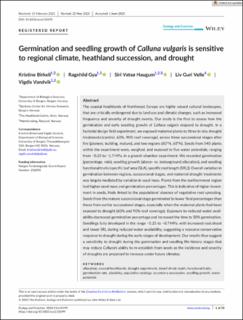| dc.description.abstract | The coastal heathlands of Northwest Europe are highly valued cultural landscapes, that are critically endangered due to land use and climatic changes, such as increased frequency and severity of drought events. Our study is the first to assess how the germination and early seedling growth of Calluna vulgaris respond to drought. In a factorial design field experiment, we exposed maternal plants to three in-situ drought treatments (control, 60%, 90% roof coverage), across three successional stages after fire (pioneer, building, mature), and two regions (60°N, 65°N). Seeds from 540 plants within the experiment were, weighed, and exposed to five water potentials, ranging from −0.25 to −1.7 MPa, in a growth chamber experiment. We recorded germination (percentage, rate), seedling growth (above- vs. belowground allocation), and seedling functional traits (specific leaf area [SLA], specific root length [SRL]). Overall variation in germination between regions, successional stages, and maternal drought treatments was largely mediated by variation in seed mass. Plants from the northernmost region had higher seed mass and germination percentages. This is indicative of higher investment in seeds, likely linked to the populations' absence of vegetative root sprouting. Seeds from the mature successional stage germinated to lower final percentages than those from earlier successional stages, especially when the maternal plants had been exposed to drought (60% and 90% roof coverage). Exposure to reduced water availability decreased germination percentage and increased the time to 50% germination. Seedlings fully developed in the range −0.25 to −0.7 MPa, with increased root:shoot and lower SRL during reduced water availability, suggesting a resource-conservative response to drought during the early stages of development. Our results thus suggest a sensitivity to drought during the germination and seedling life-history stages that may reduce Calluna's ability to re-establish from seeds as the incidence and severity of droughts are projected to increase under future climates. | en_US |

